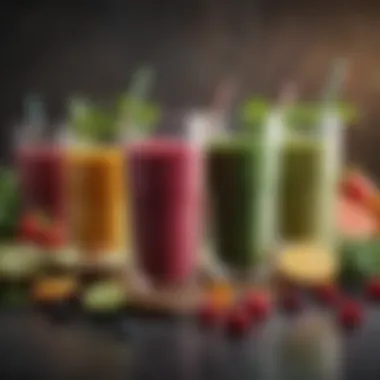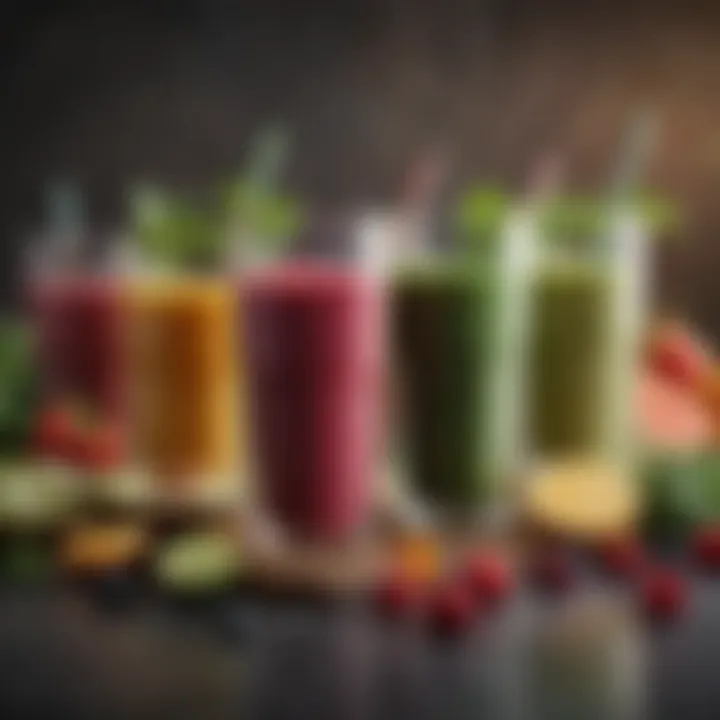Crafting the Perfect Smoothie: Key Ingredients & Tips


Intro
Crafting a smoothie isn’t just about throwing a bunch of fruits and veggies in a blender and hoping for the best. It’s a delicate art that balances flavors, textures, and nutritional needs, catering to both the palate and the body. Whether you’re a health nut, a busy parent, or simply someone who loves a good drink, smoothies have something for everyone. With the diversity of ingredients available today, you can whip up a concoction that’s not just tasty, but also leaves you feeling energized and satisfied.
From the choice of fruits that determine sweetness to the creamy elements that add body, this journey into smoothie-making is one that encourages creativity and experimentation. Let’s peel back the layers and see what goes into making that perfect blend.
Recipe Overview
Recipe Name
The Classic Berry Smoothie
Description of the Dish
Imagine starting your day with a refreshing blend of luscious strawberries, plump blueberries, and creamy yogurt. The Classic Berry Smoothie is not just a drink—it's a burst of flavor in a glass that provides a healthy dose of antioxidants, vitamins, and minerals. Ideal for breakfast or as a mid-afternoon snack, it delights both young and mature taste buds alike.
Ingredients
List of Ingredients with Measurements
- 1 cup frozen strawberries
- 1 cup frozen blueberries
- 1 banana, sliced
- 1/2 cup plain Greek yogurt
- 1 cup almond milk (or any milk of choice)
- 1 tablespoon honey or maple syrup (optional)
Special Notes on Ingredients
- Fruits: Fresh fruits can be used instead of frozen. However, frozen fruits give a creamier texture and keep the smoothie cold without diluting it with ice.
- Yogurt: For a dairy-free option, coconut yogurt works beautifully, providing a subtle sweetness.
- Milk Substitutes: Almond milk is just one option; oat milk, soy milk, or regular milk can enhance the flavor profile differently.
- Sweetness: Adjust the honey or maple syrup according to your taste. You could also skip it entirely if your fruits are naturally sweet enough.
In understanding the components that go into a smoothie, we not only appreciate the joy it brings but also the health benefits that are essential in our diets today. Stay tuned, as we journey deeper into the world of ingredients, blending techniques, and tips that can elevate your smoothie game to a whole new level.
Preface to Smoothies
Smoothies have carved out a significant place in our culinary landscape, transcending the realm of mere convenience to become symbols of healthy living. They are not just beverages; they are a canvas for an array of flavors and nutrients. Understanding the essence of smoothies is crucial as it helps to appreciate their versatility and nutritional potential. For many, including busy professionals and health aficionados alike, smoothies provide a quick fix for on-the-go nutrition.
The beauty of smoothies lies in their adaptability. You can tweak and modify them according to your personal taste preferences, dietary needs, or seasonal availability of ingredients. This article will delve into the anatomy of smoothies, exploring the ingredients, equipment, and techniques that can transform a simple blend into a culinary masterpiece. The ensuing sections will highlight selections that not only tantalize the taste buds but also pack a nutritional punch, paving the way for healthier eating habits.
Defining Smoothies
At its core, a smoothie is a blended beverage typically made from a combination of fruits, vegetables, liquids, and sometimes other ingredients such as nuts or protein powders. This blending process creates a thick, creamy drink that retains much of the nutritional content of its raw components.
Smoothies stand out from other beverages mainly due to their texture and thickness. Unlike juices which extract flavors and nutrients, smoothies embrace whole ingredients, delivering fiber in a concentrated manner. This fiber content is essential; it plays a vital role in digestion, helping to regulate blood sugar levels and keeping you satiated longer.
In essence, if you’re looking to balance taste and health, a smoothie can be your best friend. They invite creativity—be it by mixing tropical fruits in one batch or spinning a green-based veggie blend in another.
History and Evolution
The journey of smoothies stretches back to the mid-20th century during the emergence of health food movements. The term "smoothie" started gaining traction in the 1960s mainly alongside the popularization of blenders. Health enthusiasts and nutritionists recognized that these blended drinks could serve as nourishing options that retained more vitamins and minerals than conventional drinks.
Fast forward a couple of decades, and smoothies exploded in popularity during the health crazes of the 1990s and early 2000s. Numerous juice bars and smoothie chains sprouted, making them accessible to the everyday consumer.
Today, smoothies continue to evolve. They are no longer viewed merely as fad health drinks but are fully integrated into dietary practices around the world. From the addition of superfoods to personalized creations tailored for fitness goals, the landscape of smoothies is dynamic, reflecting current trends in nutrition and wellness.
"Smoothies offer a unique balance of taste and health, making them not just a beverage, but a lifestyle choice for many."
Key Ingredients for Smoothies
Smoothies are more than just a refreshing drink; they are a blend of flavors, nutrients, and creativity. The foundation of any good smoothie is its ingredients. Choosing the right components is key to achieving that desired taste and texture, along with ensuring a balance of health benefits. Each ingredient has its role, contributing to the overall profile of the smoothie. Ingredients can transform a simple mix into a delicious meal or a nutritious snack, catering to a wide range of dietary preferences and tastes. Let's explore these essential ingredients in detail, starting with the cornerstone: fruits.
Fruits: The Foundation
Fresh vs. Frozen Fruits
When it comes to smoothies, the fruit you pick can make or break your drink's flavor and texture. Fresh fruits are often juicy and packed full of vitamins, boasting a delightful taste that’s hard to beat. However, frozen fruits hold their own, too. They are convenient and often cheaper, especially when the fruits are out of season. There’s also a misconception that freezing fruits diminishes their nutritional value. In reality, many fruits are frozen at their peak ripeness, retaining their vitamins and minerals well.
The unique feature of frozen fruits is that they tend to make your smoothies nice and thick and creamy, offering that extra chill. However, if you prefer a lighter texture, fresh fruits might be your best bet.
Best Fruits for Optimal Flavor
Some fruits simply shine in smoothies. Bananas add creaminess and a natural sweetness, making them a popular choice. Mixed berries bring a delightful tang while being packed with antioxidants. Pineapple provides a refreshing tropical twist, and mango adds a velvety texture. Choosing the right combination not only boosts flavor but also enhances the nutritional value. Each fruit has its unique attributes that can affect the final outcome of the smoothie. It’s a good idea to experiment with different combinations to find what works best for your tastes.
Combining Fruits for Nutritional Benefits
Combining various fruits can create an exciting flavor profile while yielding a more rounded nutritional intake. For example, the fiber in apples can balance the high sugar content of mango, making for a delicious and healthful smoothie. Citrus fruits are great for mixing as well; they can brighten the flavors of berries and bananas alike. The important takeaway is that mixing fruits can amplify the nutrient variety you gain per serving, offering an array of health benefits with every sip.
Vegetables: Nutrient Boosters
Leafy Greens: A Versatile Choice
When thinking about smoothie ingredients, leafy greens often take a backseat. However, their role is important. Spinach and kale are nutrient-rich, capable of providing vitamins A, C, K, and various minerals. They can easily blend into smoothies without altering the taste too much, making them a versatile addition. The unique feature of leafys is their ability to boost the nutrient profile without overpowering the flavors of your smoothie, which is a key consideration for those who aren’t fans of salads. They fit right in, adding a healthy twist.
Root Vegetables: Flavor and Texture
Root vegetables, like carrots and beets, are often overlooked in smoothie recipes but they bring distinct flavors and appealing colors. Beets, for instance, offer an earthiness that pairs wonderfully with fruits like berries. Carrots add sweetness, and both are excellent sources of dietary fiber and vitamins. While they may require a bit more blending to achieve smoothness, the texture they impart can be delightful and enriching.
Balancing Vegetables with Fruits
Striking the right balance between veggies and fruits can elevate your smoothie from simple to spectacular. Using fruits with strong flavors like pineapple or mango can mask the taste of spinach or kale, making it palatable. This particular balance also allows you to sneak in veggies while enjoying the sweetness of fruits. One must pay attention to the ratio though; too many greens might overwhelm the flavors unless you master the right combinations.
Liquid Bases: Beyond Water
Juices: Natural Sweeteners
While water is a classic choice for thinning out smoothies, juices can add both flavor and natural sweetness, enhancing the overall taste. Freshly squeezed juices provide nutrients while infusing flavor without the need for overly processed sweeteners. However, it’s important to watch out for the sugar content; opting for juices like orange or apple can be beneficial, but moderation is key. Juices also offer a unique taste that can highlight or complement the fruits in your smoothie.


Dairy and Non-Dairy Alternatives
The milk you choose can dramatically alter both the flavor and consistency of your smoothie. Traditional dairy milk adds creaminess, but it’s good to consider non-dairy options like almond milk, coconut milk, or oat milk as well. Almond milk is a favorite among vegans, while coconut milk offers a unique tropical flavor. The distinct characteristic of non-dairy alternatives is that many are low in calories and can cater to lactose-intolerant individuals. On the downside, some don’t provide as much protein as dairy products do.
Broths and Herbal Infusions
Using broth or herbal infusions is an unconventional approach to smoothie making, but it’s gaining traction. Vegetable broth can add a salty depth and help to create a savory smoothie, which may be a more substantial option for meal replacements. Herbal infusions, such as chamomile or mint tea, can introduce a unique flavor while offering additional health benefits. The unique feature here is the complexity these liquids can bring to a seemingly simple drink; however, one must tread carefully to avoid overpowering the main fruit flavors.
Proteins and Powders
Whey and Plant-Based Options
Protein is paramount for enhancing the overall nutritional value of smoothies, especially if you intend to use them as meal replacements. Whey protein is popular due to its quick absorption and complete amino profile, making it seem like a go-to among fitness enthusiasts. On the other hand, plant-based proteins like pea or rice protein are gaining attention for their digestive benefits and capability to cater to various dietary needs. It’s a beneficial idea to explore both of these options depending on personal preferences and dietary restrictions.
Superfood Powders: Benefits and Use
Superfood powders, like spirulina or acai, are becoming a key player in the world of smoothies. They provide concentrated health benefits without taking up much space in your blender. The unique characteristic of superfood powders is that they can give your smoothie an extra nutrient boost. However, one must ensure moderation here because too much can alter the flavor dramatically.
Integrating Protein for Meal Replacement
Integrating protein into your smoothies can turn a snack into a filling meal. Instead of just relying on fruits and greens, adding protein can help in maintaining satiety longer. However, you need to balance the amount so that it does not overshadow the natural flavors of the other ingredients. A well-integrated meal replacement smoothie can give you a solid energy hit, particularly post-workout.
Extras: Toppings and Add-Ins
Nuts and Seeds for Crunch
The addition of nuts and seeds adds not only a satisfying crunch but also a boost in healthy fats and proteins. They can transform a classic smoothie into a more textured experience. Chia seeds or flaxseeds can infuse omega-3 fatty acids while nuts like almonds or walnuts add a unique flavor and maintaining an appealing nutrition profile. However, one must keep the portion sizes in check to avoid exceeding calorie requirements.
Sweeteners: Natural vs. Processed
Sweeteners can make a big difference, and choosing the right kind is essential. Natural sweeteners like honey, agave, or dates can elevate the taste without introducing harmful additives. On the other hand, processed sweeteners can contain chemicals that devalue your otherwise healthy smoothie. The key takeaway here is to choose sweeteners wisely; they can bulk up calorie counts quickly, especially if used excessively.
Spices and Flavor Enhancements
Using spices might sound a bit unorthodox, but they are a game changer for achieving a unique taste. Cinnamon, nutmeg, or ginger can add warmth and complexity to your smoothie blend. They also come with additional health benefits, like aiding digestion. However, sift carefully when adding spices; a little goes a long way and too much could overpower your drink.
Essential Equipment for Smoothie Making
Creating the perfect smoothie goes beyond just choosing the right ingredients. The equipment you use plays a pivotal role in determining the texture, taste, and overall experience of your beverage. Quality equipment enhances efficiency, preserves nutritional value, and provides a consistent end product. Neglecting this vital aspect may lead you down a path of frustration or, worse, bland smoothies.
In this section, we will focus on two key areas: blenders and storage solutions. By understanding the different types of blenders and appropriate storage tools, you'll be better equipped to create delicious, nutrient-rich smoothies at home.
Blenders: Choosing the Right One
When choosing a blender, it’s essential to consider your specific needs and how frequently you plan to whip up smoothies. Not all blenders are created equal, and some are specifically designed for particular tasks.
Types of Blenders Explained
There are several blender types serving different functions:
- Countertop Blenders: These are the workhorses of the smoothie world. They offer high power and larger jars, perfect for bigger batches.
- Immersion Blenders: Great for quick blending directly in your glass or container, though they can struggle with harder ingredients.
- Single-Serve Blenders: Compact and user-friendly, ideal for those who whip up smoothies on-the-go.
The most prominent choice for smoothies generally gravitates to countertop blenders. They blend seamlessly, are user-friendly, and often come equipped with various speed settings.
Power and Blade Quality Considerations
The blender’s power is a crucial factor. A motor with at least 500 watts can handle frozen fruits and ice with ease. Blade quality matters too. Sturdy, stainless-steel blades can crush tougher ingredients faster and more efficiently, making for a smoother finish.
It's worth noting that a high-powered blender might come with a heftier price, but the advantages often outweigh the costs. A reliable, robust machine might save you time and result in a consistently better smoothie.
Price Range and Features to Look For
When considering blenders, you should evaluate your budget alongside desired features. Basics include speed settings, any pre-programmed smoothies, and easy cleanup systems. A decent countertop blender ranges between $50 and $300, depending on its features.
In essence, a model with a powerful motor and multiple settings can both save time in the kitchen and provide culinary versatility, making it an invaluable tool for any smoothie enthusiast.
Storage: Tools for Freshness
Proper storage is key to maintaining freshness and maximizing the nutritional profile of your smoothies. The right containers can help keep your ingredients and finished smoothies at their best.
Containers for Prepped Ingredients
Whether you prep your ingredients a day in advance or need storage for leftover smoothies, containers make a world of difference. Look for airtight containers to keep fruits and veggies fresh longer. Glass containers are popular since they won't absorb odors or stains but can be heavier.
Tupperware with dividers helps organize fruits, greens, and nuts without mixing flavors. This systematic approach ensures that you always have prepped ingredients on hand, reducing the hassle during the blending process.
On-the-Go Smoothie Bottles
For those with a bustling lifestyle, on-the-go smoothie bottles are a real game changer. These bottles often come with built-in straws and are designed to be leak-proof, ensuring you can enjoy your healthy drink regardless of where life takes you.
Many options are also insulated, helping to maintain your smoothie’s temperature. Opt for BPA-free plastic or stainless steel to ensure safety and durability. However, keep in mind the importance of regular cleaning, as residue can build up if not managed.
Preservation Techniques for Smoothies
To keep smoothies fresh longer, consider freezing portions in ice cube trays or using vacuum-sealed bags. Freezing not only preserves flavor but also retains nutrients. Should you make a batch, always allow for some space in your container as liquids expand when frozen.
Techniques for Optimal Blending
Crafting a smoothie is much more than simply tossing ingredients together and pressing a button. To achieve that creamy, delicious concoction that satisfies both taste buds and nutritional needs, mastering the techniques of blending is critical. From knowing the right order in which to layer ingredients to understanding how to adjust consistency and texture, these skills ensure that every blend is a triumph rather than a tragedy. This section explores these essential techniques to elevate your smoothie-making game.


Layering Ingredients for Best Results
The Science of Blending Order
When it comes to assembling your smoothie, the order of ingredients is not just a trivial choice; it's a key factor that contributes to the overall texture and taste of the final product. Starting with liquids at the bottom creates a vortex of motion, ensuring that the blades can quickly incorporate denser items above. You might think of it as building a house, where a solid foundation is key to a sturdy structure.
Key Characteristics:
- Liquid first, then softer ingredients, followed by harder items.
- Helps achieve uniform consistency and aids blending efficiency.
This technique benefits the blending process because it prevent clumps and ensures everything mixes evenly. However, a common pitfall is to overlook the delicate balance of ingredients. The unique feature here is the ability to avoid mini dry spots that linger if less liquid is placed last. However, if floats of fruits or leafy greens enter at the top, there's always a risk of not fully blending smaller particles, leading to undesirable grit in the smoothie.
Texture Considerations
The texture of your smoothie can make or break the experience. If you've ever tried a smoothie that felt more like sludge than a silky drink, you understand this notion well. Texture considerations can guide you through crafting that mouth-feel which enhances the overall flavor experience.
Key Characteristics:
- Creaminess can be enhanced with avocados or yogurt.
- Use of different fruits creates unique textures.
This focus on texture allows you to customize your smoothie based on personal preference. For instance, using bananas or nut butters can add creaminess, while berries may offer a chunky bite. But every pro has a con; overusing ripe bananas may cause overwhelming sweetness. So, understanding the combination and ratios plays a pivotal role here.
Avoiding Over-Blending
While it may seem intuitive to keep blending until everything is smooth, there's a fine line between perfectly blended and overly blended. Over-blending can result in a liquefied creation that lacks body and character.
Key Characteristics:
- Short blends followed by quick checks to ensure desired pump.
- Maintaining some texture can enhance overall appeal.
This technique is especially beneficial because it allows for the retention of some nutrients that may be lost through prolonged blending. The unique aspect of avoiding this mistake is ensuring that you have an appealing smoothie that also preserves the integrity of your ingredients. It might mean an extra minute of care but leads to a satisfying blend that nourishes and delights.
Adjusting Consistency and Texture
Thick vs. Light Smoothie Preferences
Consistency is a matter of personal taste. Do you prefer a smoothie that you can drink through a straw, or one that's thick enough to eat with a spoon? Understanding these preferences is essential for creating the perfect blend.
Key Characteristics:
- Thicker smoothies often contain nut butters or chia seeds.
- Lighter options usually emphasize fluid ingredients.
Being aware of this can enhance the overall experience. Some people might love the indulgent texture thickening offers, while others favor a lightweight drink that goes down easy. Just remember that adjusting consistency isn't only about preference but also about the intended use of the smoothie; thick ones are often more filling, while lighter ones may serve as a refreshing snack.
Using Thickeners and Gels
If you're aiming for that perfect creamy consistency, thickeners and gels are your friends. Items like chia seeds and flaxseeds, once soaked, shift a smoothie’s consistency dramatically without overpowering flavors.
Key Characteristics:
- Natural thickeners can be a source of fiber.
- Encourage a more substantial texture without added calories.
This technique opens doors to nutritional benefits that they bring to the table. These ingredients contribute added health benefits while enriching the texture. Just be cautious—too much of a good thing can turn your smoothie into an unappealing blob!
Altering Texture with Ice Variations
The use of ice is a classic method for achieving that refreshing chill, especially in summer. But it's not only about temperature; ice can also significantly modify the texture of your smoothie.
Key Characteristics:
- Crushed ice offers a smooth, slushy texture.
- Larger ice chunks can lead to a grainy feel.
Different forms of ice play uniquely in the blending process. If you're shooting for a thicker, slushy style, using smaller or crushed ice helps create that dreamy consistency. But be wary of using too many ice chunks—this can lead to an uneven texture that's less than desirable in a smoothie. Ultimately, it’s all about moderation and adjusting according to your distinct palate.
Health Considerations in Smoothie Preparation
When it comes to crafting a smoothie, the health implications can’t be sidelined. Smoothies may taste like indulgent treats, but they can easily morph into nutritional powerhouses if one pays attention to what goes into them. Whether you are aiming for a quick breakfast or a post-workout replenisher, keeping an eye on health considerations boosts both enjoyment and nutritional value. Focusing on balanced profiles, dietary regulations, and ingredient alternatives ensures that everyone can savor the benefits of smoothies without worry.
Balanced Nutritional Profiles
The Importance of Macronutrients
Macronutrients lay the foundation for a well-rounded smoothie. You refer to three main types: carbohydrates, proteins, and fats. Each plays a distinct role, fueling the body in ways that enhance both physical and mental performance. Carbs supply immediate energy - think of that banana before a workout. Proteins, whether from yogurt or plant-based sources, help repair muscle and keep you feeling satisfied. Lastly, healthy fats, like those from avocados, provide lasting energy and vital nutrients.
A key characteristic of macronutrients is their measurable impact on overall wellness. They help maintain blood sugar levels and can contribute to muscle mass if you engage in regular exercise. The unique feature is that every ingredient you choose can be tailored to balance these macronutrients according to your individual goals, be it weight loss, muscle gain, or simply maintaining a healthy lifestyle.
Vitamins and Minerals Incorporation
Vitamin and mineral incorporation is another essential aspect of smoothies that shouldn’t be overlooked. Incorporating a colorful array of fruits and vegetables can significantly enhance the vitamin content. For example, spinach is low in calories but packed with iron and calcium, while oranges provide a hefty dose of vitamin C. This not only supports immune function but aids in overall health and energy levels.
What makes this aspect beneficial is the ease with which one can blend various ingredients. You can toss in some kale or berries without breaking a sweat. However, one should be aware of potential trade-offs; too much fruit can lead to excessive sugar intake, even if it’s natural. Striking the right balance between flavors and nutrients is crucial.
Caloric Considerations
While smoothies can certainly be healthy, caloric considerations are an aspect that deserves attention. It’s easy to lose track of calories when crafting your concoctions, particularly with the abundance of high-calorie add-ins like nut butters or sweeteners. Keeping track of the total caloric intake becomes essential, especially for those monitoring weight.
By understanding the calorie content of each ingredient, you can create a satisfying yet appropriate smoothie. The important part here is balance – opting for low-calorie options while still ensuring satisfaction. It’s a beneficial choice for anyone on a health journey, but it may be daunting for novice smoothie makers.
Dietary Restrictions and Adaptations


Dietary restrictions are a reality for many people today. Fortunately, smoothies can easily be adapted to meet diverse needs.
Gluten-Free Alternatives
Gluten-free alternatives are incredibly helpful for those with celiac disease or gluten sensitivity. Fortunately, many fruits and vegetables are naturally gluten-free, allowing for delicious mixtures without any fuss. Those who opt for gluten-free grains, such as quinoa or oats, can also find ways to blend them into a smoothie without the added irritants.
The key characteristic of these alternatives is inclusivity; they make it possible for a variety of people to enjoy smoothies without fear of an adverse reaction. On the downside, one must always be diligent about cross-contamination in bulk products, as it can be a hidden concern.
Nut-Free Options
Nut-free options are equally essential for those with allergies or sensitivities. Substituting nuts with seeds like chia or flax not only avoids allergens but adds a unique taste and additional nutrients. Furthermore, using coconut milk or rice milk can maintain creaminess without the risk of nut allergies.
This approach lends itself well to creating unique flavors while ensuring safety. However, it may limit the range of healthy fats available, thus requiring careful ingredient selection to avoid deficiencies.
Vegan and Vegetarian Considerations
Vegan and vegetarian considerations open even more doors for creativity in smoothie making. Plant-based diets emphasize nutrient-dense ingredients – think lentils, beans, and an array of seeds. These diets promote health benefits like lower cholesterol levels and improved heart health.
An essential characteristic of vegan and vegetarian smoothies is their environmental footprint; opting for plant-based sources can contribute positively to sustainability. However, the challenge remains to ensure adequate protein and iron intake, which might necessitate incorporating specific powders or fortified options for balance.
The beauty of smoothie preparation lies in its adaptability. A well-thought-out blend can cater to numerous health considerations, making it possible for everyone to enjoy this popular treat.
By taking these health considerations to heart, smoothie crafting becomes not just an exercise in flavor exploration but a commitment to well-being.
Creative Combinations and Recipes
In the quest for the perfect smoothie, creativity plays a pivotal role. Exploring creative combinations and recipes offers a chance to marry flavors and nutrition in unexpected ways, resulting in concoctions that not only tantalize the taste buds but also nourish the body. Classic recipes serve as a springboard, while innovative additions can elevate the experience into something remarkable. The balance of flavor, health benefits, and personal preference becomes the guiding force in crafting enjoyable smoothies.
Classic Smoothie Recipes
Traditional Fruit Smoothies
Traditional fruit smoothies are the backbone of this genre; they typically showcase familiar ingredients like bananas, berries, and mangoes. Their key characteristic lies in their simplicity: just blend any favorite fruit together with a base like juice or yogurt for a satisfying drink. This easy-to-throw-together option has long been a favorite, particularly among those who might not be comfortable experimenting with flavors too far outside the norm.
One of the unique features of traditional fruit smoothies is how approachable they are for beginners. They require minimal prep, and the balancing of sweetness and acidity can often reset culinary disasters. However, they may lack the complete nutritional profile that can be achieved with more diverse ingredients.
Vegetable-Forward Blends
Vegetable-forward blends shine by highlighting the versatility of greens and roots, from spinach to beetroot. The significance of these blends stems from their ability to pack an enormous punch of vitamins while often being lower in sugars compared to their fruity counterparts. A blend like this, often includes less recognizable ingredients like kale or chard, which can be a bit of a leap for the uninitiated.
A major advantage of vegetable-forward blends is that they can be adjusted to mask the taste of stronger vegetables with fruits, offering a gentle entryway into a veggie-rich diet. On the flip side, some might find these mixtures unappealing due to the bitterness that often accompanies leafy greens; hence, achieving the right balance can take some finesse.
Protein-Packed Smoothies
Moving into the realm of protein-packed smoothies, these blends often incorporate sources like Greek yogurt, powdered protein, or even nut butters. They are particularly suitable for those looking to enhance their diet post-workout or for meal replacement. The characteristic of protein-packed smoothies is their ability to promote satiety, which can be crucial in managing weight or fueling intense physical activity.
What sets these smoothies apart is their unique feature of being highly customizable. From varying levels of creamy texture to the addition of rich flavors like chocolate or cinnamon, the options can feel endless. However, a potential drawback is that balancing taste with protein content can sometimes lead to drinks that feel overly dense or heavy, which might not appeal to everyone.
Innovative Additions
Using Unconventional Ingredients
Incorporating unconventional ingredients, such as chia seeds, spirulina, or even adaptogenic herbs, can take one’s smoothie from ordinary to extraordinary. These additions not only contribute unique flavors but also enhance the nutritional profile. The importance of such ingredients lies in their potential health benefits, from increased fiber intake to improved gut health. The exciting aspect of this approach is how these ingredients can shift smoothies into health-enhancing elixirs rather than mere beverages.
Nonetheless, a downside might be the learning curve associated with balancing these bold flavors in a pleasing way. Beginning with one or two unfamiliar components at a time can help avoid overwhelming the palate.
Cultural Influences in Smoothie Creation
The impact of cultural influences on smoothie creation cannot be overstated; different cultures contribute unique flavors and ingredients. For instance, adding tropical fruits or spices can introduce an exotic flair that infuses the familiar with a twist of the unexpected. What makes this aspect so engaging is the opportunity to explore and understand different gastronomic histories through a simple drink.
However, it’s essential to be cautious, as some flavor combinations might not align well with everyone’s palate, leading to less appealing outcomes. Understanding cultural pairings can bridge these gaps.
Seasonal Ingredients for Freshness
Finally, the use of seasonal ingredients for freshness can enhance both flavor and nutritional value. Seasonal fruits and vegetables not only ensure better quality but also allow for a natural variance in taste across different times of the year. The key characteristic involves a reliance on local produce, which can boost freshness and support local economies. Such practices often lead to a richer, more varied palate experience.
Yet, seasonal ingredients can pose a challenge, particularly if desired items are out of season, leaving one to either wait months or fall back on less satisfying options. Understanding which ingredients are at their peak can ensure that every smoothie remains vibrant and fulfilling.
Taking time to explore combinations and adjust ingredients according to personal preferences not only improves smoothies but turns the experience into something much more enjoyable!
Crafting a smoothie is not just a simple blend; it’s an opportunity for artistry in the kitchen. Embracing creative combinations allows for endless exploration, balancing health and happiness in each sip.
Epilogue
The conclusion of this article stands as a crucial element for readers, summing up the rich and detailed tapestry woven throughout the discussion on crafting the perfect smoothie. The reader should walk away with a clear insight into how various ingredients, tools, and techniques combine to create not just a drink, but an experience.
Recap of Essential Components
When it comes to creating superb smoothies, one cannot overlook the importance of comprehending the core components that contribute to their success. Each ingredient plays a distinct role:
- Fruits and Vegetables form the heart of your smoothie. They offer flavor and nutrition, bringing color and taste to your blend.
- Liquid Bases, whether it be water, juice, or nut milk, are just as important. They determine the consistency and overall mouthfeel of the smoothie.
- Proteins and Powders provide not only sustenance but also add another layer of flavor, making it a satisfying option whether as a meal replacement or a snack.
- Toppings and Extras like nuts, seeds, or spices not only enhance flavor but also add valuable nutrients.
Understanding these components allows anyone to tailor smoothies to personal preferences and dietary needs. Each aspect complements the other, working harmoniously to deliver nourishment without sacrificing taste.
Encouragement for Culinary Exploration
The essence of crafting smoothies lies in the adventure of exploration within the kitchen. Readers are encouraged to use the foundational knowledge provided here as a springboard to test their culinary limits. Don’t be afraid to experiment! Try incorporating unexpected ingredients like avocado for creaminess or herbs like basil for a refreshing twist.
Dive into the world of flavors. Mix a tropical pineapple with earthy spinach or blend a classic banana with a hint of cinnamon for warmth. Seasonal ingredients can also bring a whole new vibe, allowing for creativity to shine while leveraging what’s fresh and available.
"Cooking is an art, but getting it right is a science."
This statement rings true for smoothies too. Understanding the basic ratios and methods equips one with the confidence to explore further. It can lead to delightful surprises—the kind that makes taste buds dance and smiles widen.
Encourage conversations with others who share this culinary interest, be it in-person or through online communities. Reddit and Facebook groups, for example, often share new ideas and recipes, enabling aspiring smoothie makers to broaden their horizons.
By delving into this vibrant world of smoothie concoctions, you can craft beverages that not only suit your palate but also spark joy and inspire creativity. Each blend tells a story and offers a chance to nourish both body and soul.







